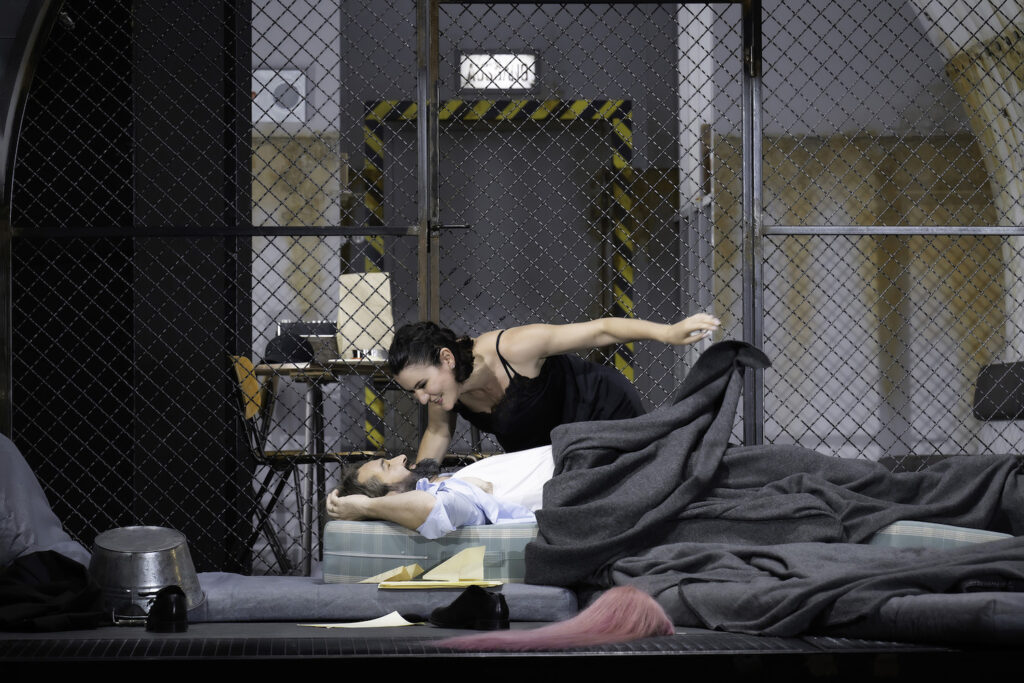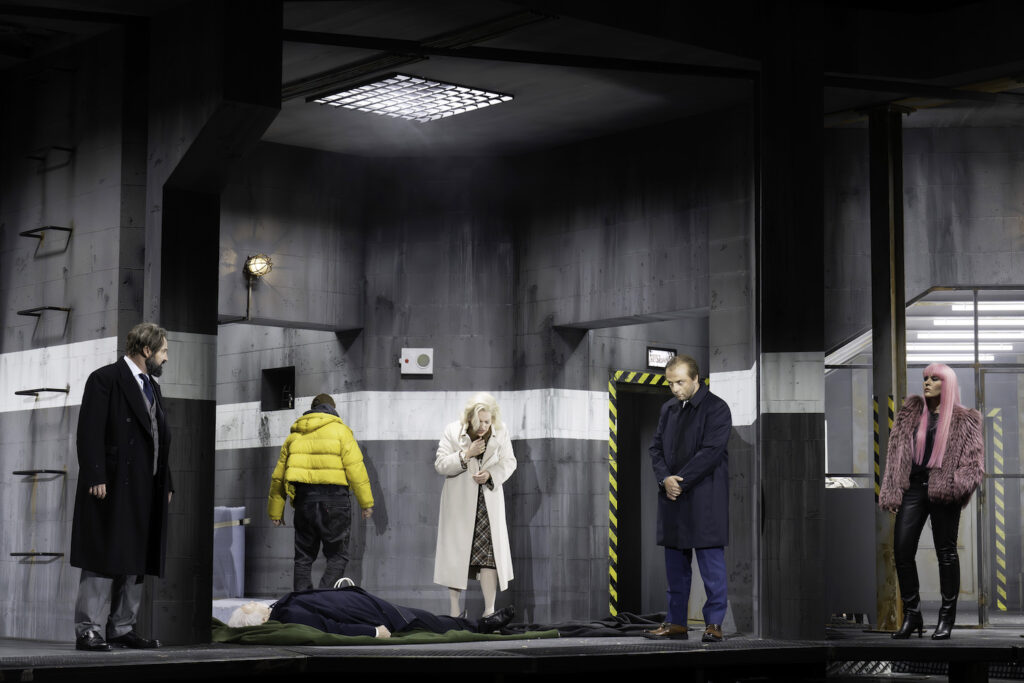Stage director Dimitri Tcherniakov sets Handel’s most performed opera in an air raid shelter (where else these days?), wittily deploying a direct hit on the shelter to announce Cleopatra’s scorching “v’adoro pupille,” Baroque’s Virtue is nowhere in sight.
And never was. It was eight, stuck characters in search of a author. A victim was dragged in, let’s call him Pompeo. A story indeed unfolded, a woman took on the role of his widow named Cordelia (contralto), a willowy kid took on the role of her son, Sesto. She sang a soul wrenching lament while touching up her makeup and hair.
The first act ends with another soul wrenching lament — a duet with her countertenor (high soprano) son that left them sitting together, legs dangling over the lip of the stage into the pit. Black out. But it wasn’t the intermission. The stage was again lighted, sitting exactly in the same position were Cleopatra (a sumptuous soprano) and her confident Nireno (countertenor) plotting her Act II seduction of Cesare.

The seduction bomb dropped (the theater shook), and a celestial orchestra was wittily revealed. high above the stage.
There was a plot to kill Cesare (you know the story). He was summarily dispatched [pistol shots into his heart] though he came back to life and jumped into the pit —the libretto’s sea. The pit was an integral part of the set, as we had perceived early on.
This was the core of the Tcherniakov metaphor: Handel’s opera as an abstract music drama [Cleopatra absurdly comforted her wicked brother Tolomeo (countertenor) during her famed “Piangero,” Cornelia attempted to rape her son who said he was now a man — but really wasn’t, etcetera].
Integral to Tcherniakov’s “Gesamtkunstwerk” was conductor Emmanuelle Haīm’s Le Concert d’Astrée in sounds that can be described as Wagnerian in richness of tone, the heavy continuo (double cellos, lutes, and cembolos, plus contrabass) was of unusual richness as well, blurring the recitatives into the arias. The string count, 7/6/5/5/3, playing on gut strings (presumably), created an homogeneity of mellow tone that permeated the happenstance dramatic action, and bound it into abstract, musico-dramatic totality.
Eventually (Act III) Cesare (countertenor) and Cleopatra wearily (though both in beautiful voice) found their way to to the lip of the stage, legs dangling, to sing their love duet, making a L’incoronazione di Poppea-like, quite arbitrary ending — Cleopatra crowned, at last, Queen of Egypt, and now so what.
Though in the opera’s final moments, sitting on the lip, legs dangling, spread across the stage, were all eight characters, thoroughly worn-out, their (or a) story told, with nothing left to say, against the Handel’s triumphant postlude and celebratory chorus.
It was huge orchestral sound, shining with Handelian wind and reed colors, the horns magnificent in their battles and victories, sounds that enveloped the arias pouring forth, without reserve, from the stage — there was no hint of a rarified Handelian musical Parnassus. The disjoint of stage action [Sesto’s tantrums, Tolomeo’s rape of Cordelia, etcetera] to musical content served to heighten Tcherniakov’s musico-dramatic tensions, creating complex, strangely cohesive, challenging theater.
Although Giulio Cesare may have the first aria, his splendid, florid “Va tacito e nascosto” (the hunter goes after his game [lots of horn]), set the stage for Tcherniakov’s idea of a hunt. It was not about finding the Virtue of Caesar’s magnanimity, it was about a willful young woman finally getting her way and the sexual quests of an insecure matron, who found themselves together in an air raid shelter, with no exit.
Mr. Tchernikov employs a fight director / choreographer, Ran Authut Braun, to create the Strehler-like physical theater that abounds in his productions. The kid Sesto (lead photo) was an eager candidate, as was Giulio Cesare himself, jumping into the pit. It was quite a convention of four lively countertenors. While it may be dramatically reassuring to see males in male roles, a preponderance of the male falsetto timbre robbed Handel’s opera of much of its potential vocal — and sexual — richness.

There were but two female voices in this production. Cleopatra was sung by Ukrainian soprano Olga Kulchynska in warm and rich diva tone. Cornelia was sung by French contralto Lucile Richardot in a broad, flat character voice that she used to moving advantage in her laments and to great effect in her rejection of declared, unwelcome affection.
The lecherous Tolomeo’s equally lecherous henchman Achilla was sung by Moldavian baritone Andrey Zhilikhovsky. Handel felt compelled to award him one brief aria. Caesar’s confident Curio was sung by American baritone Robert Raso, a participant in the Festival’s young artist program.
Giulio Cesare was sung in a quite beautiful, if small voice by French countertenor Christophe Dumaux; Sesto was sung by Italian male soprano Federico Florio; Tolomeo was gruffly voiced by Ukrainian countertenor Yuriy Mynenko; and Cleopatra’s eunuch Nerino was sung by American countertenor Jake Ingbar.
As is usual Dimitri Tcherniakov designed the sets as well as directed the opera. He was supported by his usual Russian collaborators Elena Zaytseva (costumes) and Gleb Filshtinsky (lights).
Michael Milenski
Haus für Mozart, Salzburg, Austria, July 14, 2025
All photos copyright Monika Ritterhaus, courtesy of the Salzburg Festival.